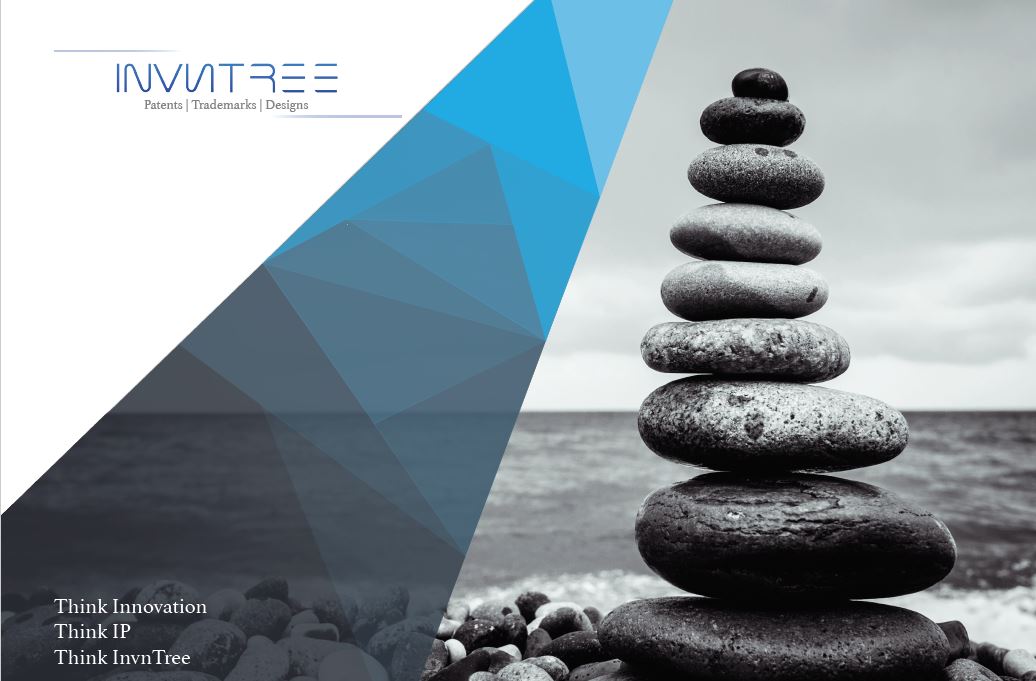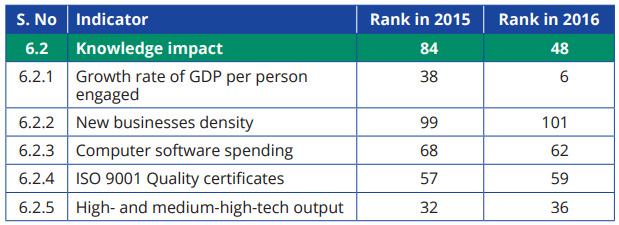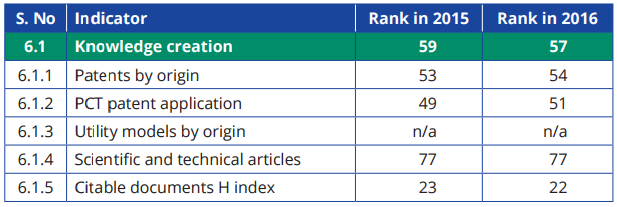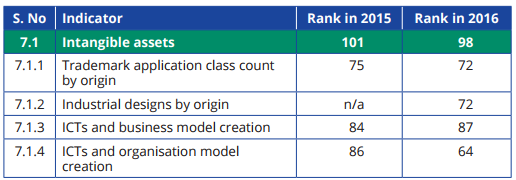Tag Archives: india innovation ranking
Parliamentary Standing Committee Recommendations for Expanding the Innovation Ecosystem in India

In an attempt to strengthen the IPR regime in India a comprehensive national IPR policy was adopted in May 2016. Further, a Parliamentary Standing Committee on Commerce was assigned with a task to evaluate the progress achieved at the end of five years since the time the national IPR policy was adopted. The Committee submitted a review report on the Intellectual Property Rights Regime in India after reassessing the Policy to identify the gaps in its implementation and strategize the way forward. In its exhaustive review report, the Committee has recommended ways to incentivize innovations and creativity, strengthen the IPR regime through IP financing, encourage IPRs in agriculture, tribal cures, etc., and ways to protect new and emerging trends in the latest technologies.
Some of the key features identified by the Committee for protecting the overall public interest in innovation are as listed below:
- Economic contribution of IPR.
- Marking published patent applications as ‘Patent Pending’
- Spreading awareness of IPRs across all strata of societies in India.
- Handling Counterfeiting and piracy in a more stringent manner
- Filling up the pending vacancies in the IPR offices to speed up the examination and disposal of IP applications.
- Amending IP related law to address cutting edge technologies such as Artificial Intelligence (AI) and machine learning.
- Reconsideration of the abolition of the IPAB
- Impact assessment of the Japan PPH model to strategize the way forward for establishing PPH with other countries.
- Encourage IP backed financing in India.
- Amendments to section 3(b) of Indian Patent Act, 1970.
- Reduce the timeline to file an examination report request.
- Provide flexibility in patent law concerning patent abandonment.
- Amendment to Section 104 of the Indian Patent Act, 1970.
- Temporary Compulsory license for IP related to COVID vaccine manufacturing in India.
- Amendments in Form 27 of Indian Patent Act, 1970.
- Use the ‘Thirds Model’ from the Catapult system of UK, for linking academia and industry.
- Communities or individuals exhibiting traditional knowledge must reap the benefits from the IPR regime.
- Encourage IPR in agriculture.
One of the major takeaways from this report is the emphasis on accelerating IP financing. The Committee emphasized that financing in IPR must be encouraged in a comprehensive manner. The Committee has recommended to treat IP as an intangible asset based on which either loans can be provided, or tax exemptions may be made to attract more and more inventors to protect their inventions lawfully.
Also, the Committee has observed that despite adopting a National IPR policy, very little was done on ground in relation to funding for research and development. To address the same the Committee recommended the use of ‘Thirds model,’ that dealt with a ‘Catapult system’ of UK for funding research. The ‘Thirds model’ involves one third of the funding to be from a core grant from the Government, one third of the funding from industry partners and the remaining one third of the funding from a grant from collaborative R&D funds for and by consortia involving Catapults.
Further, the Committee has recommended State governments to extend tax rebates and provide incentives to companies and innovators at the local level on filing of patent and grant additional rewards on the approval of the patents.
Also, the Committee has suggested to label the patent applications that are published as ‘Patent pending’, to acknowledge the credibility of the patent application that in turn would assist the patentee as a marketing tool.
IP Financing in particular, has been observed as the key factor for expanding the IPR ecosystem. Typically, protection of inventions using patents is cost intensive process, wherein the cost includes attorney fees and patent office fees. The high costs involved in patenting inventions is a major hurdle that keeps many small entities from pursuing the IPR. Therefore, financial benefits either by providing incentives, funding for research or by reducing the patent office fees for certain entities like startups, may motivate the entities to protect their innovations using IPR. Further, by easing the affordability of patenting inventions, innovators from different socio-economic backgrounds and different age-groups can be included into the IPR ecosystem.
It is imperative that the Government considers the proposals of the Committee to strengthen the IPR regime and makes changes to the IPR policy to increase the participation in innovation that will result in a fair competition in industrial, economic, social, scientific, and technological spheres.
Please feel free check our services page to find out if we can cater to your requirements. You can also contact us to explore the option of working together.
Best regards – Team InvnTree
This work is licensed under a Creative Commons Attribution-Non Commercial 3.0 Unported License
India’s rise in the Global innovation index ranking

The Global Innovation Index (GII) released the Global Innovation Index 2017 in June 15, 2017, in which India stood at the 66th rank. The GII 2017 lists 127 countries according to various aspects that are responsible for innovation. It is co-published by Cornell University (New York), INSEAD graduate business school (France), and the World Intellectual Property Organization (WIPO, an agency of the United Nations).
The GII focuses on innovation and uses a broad variety of information and sources for capturing data to develop the Index. The GII collates information related to seven sub-indexes, which comprises five input indexes and two output indexes. The five input indexes are: (1) Institutions, (2) Human capital and research, (3) Infrastructure, (4) Market sophistication, and (5) Business sophistication. The two output indexes that capture actual evidence of innovation outputs are (6) Knowledge and technology outputs and (7) Creative outputs.
India’s Department of Industrial policy and Promotion (DIPP) set up a ‘Task Force on Innovation’ which was tasked with assessing innovation creation and suggesting measures to enhance the innovation ecosystem in India in order to improve India’s GII ranking. The Task Force comprises government officials and experts from private organisations and academia. This team published an in-depth report after studying the Global Innovation Index 2017. The report compares rankings from 2015 and 2016, giving a clear-cut picture of how we have progressed in this time duration, and provides recommendations of various schemes and plans that can be implemented.
In particular, the output index ‘knowledge and technology outputs’ includes several indicators belonging to Intellectual Property. The ‘knowledge and technology outputs’ index comprises three sub-pillars, namely Knowledge creation, Knowledge impact and Knowledge diffusion, resulting in fourteen individual indicators altogether. The following tables showcase our rankings based on data collected in 2015 and 2016 (the GII 2017 report ranks nations based on 2016 data).
We witnessed an improvement in the ranking of the knowledge and technology outputs index. 2016 saw an overall improvement in all three segments, and a particularly commendable improvement seen in the knowledge impact indicators, wherein our rankings rose by 36 ranks.
The knowledge creation sector did not see much of a rise in rankings. Further, it is worth noting that while the ranking for ‘Scientific and technical articles/ bn PPP$ GDP’ has remained the same, the score for the same has decreased from 7.5 to 7. The report mentions Uchchatar Avishkar Yojana (UAY) and Impacting Research, Innovation, and Technology (IMPRINT), both of which are Government programs that may aide intellectual property creation.
Further suggestions stress on the importance of improving the availability and quality of education. There needs to be a focus on higher education, namely graduate programs and higher programs, while stressing upon research in fundamental as well as applied knowledge.
Another point to note here is that these indicators only capture data created by formal systems. However, there are numerous innovations occurring informally, at various levels. There is a requirement for a bridge linking formal knowledge as well as informal. Including this informal, unaccounted data would greatly benefit the Government as well as the people, along with increasing our rankings in this area.
Knowledge impact
The knowledge impact sector witnessed a considerable rise in rankings from the 84th rank in 2015 to the 48th rank in 2016. The major cause for this is the increase in rankings of ‘Growth rate of GDP per person engaged (constant 1990 PPP$)’ from the 38th rank to the 6th rank in the world.
 In case of knowledge impact, there is a need to create awareness on various opportunities available through the State and Central government. Proper knowledge must be imparted to the public with respect to any available benefits and schemes so that interested people or organizations may put them to good use.
In case of knowledge impact, there is a need to create awareness on various opportunities available through the State and Central government. Proper knowledge must be imparted to the public with respect to any available benefits and schemes so that interested people or organizations may put them to good use.
The report also mentions that programs and initiatives like Make in India, Start Up India, Smart Cities across the country, Industrial Corridor etc. would give a positive impact to the GDP growth in India.
Knowledge diffusion
The improvement in the knowledge diffusion sector was driven mainly by the ‘FDI net outflows, % GDP’, which saw a rise in ranking from the 92nd rank to the 60th rank. FDI net outflows is defined as the “net outflows of investment to acquire a lasting management interest (10% or more of voting stock) in an enterprise operating in an economy other than that of the investor.” It is also important to note we rank 1st in the world for ICT (Information and Communication Technologies) services exports, which was retained from 2015.
There is definitely a need for increasing a general awareness of IP among the public. Such awareness is especially required among Micro, Small & Medium Enterprises (MSMEs), since they are creating innovation but aren’t protecting it or utilising existing IP laws to gain the best benefits possible. IP protection in India must be improved.
Another indicator that concerns IP can be found in the ‘Creative outputs’ index, in which India’s rank improved by 1 from a ranking of 95th in 2015 to a ranking of 94th in 2016.
In particular, the ‘intangible assets’ sector concerns trademark applications and industrial designs, as shown below.
An increase in awareness regarding the identification, recognition and registration of trademarks and industrial designs among public, start-ups and MSMEs must be implemented. Further, Intellectual Property Facilitation Centres (IPFCs) should be strengthened and further replicated in all the districts; IP Cells need to be established in all Universities in India. This can result in higher IP filings that result in an improvement of our ranking in these sectors.
Overall, India witnessed a commendable rise in the Global Innovation Index Rankings, jumping from the 81st rank in 2015 to the 66th rank in 2016. The GII-2017 report states, “India is a good example of how policy is improving the innovation environment”. Schemes such as Start-up India, IMPRINT, UAY, Make in India and Industrial corridor, among many others, provide an encouraging view on improving innovation and industry. We hope that with the proper planning and implementation of such schemes, India may finally live up to its potential for Intellectual Property.
We hope this article was a useful read.
Please feel free check our services page to find out if we can cater to your requirements. You can also contact us to explore the option of working together.
Best regards – Team InvnTree
This work is licensed under a Creative Commons Attribution-NonCommercial 3.0 Unported License

 Follow
Follow






